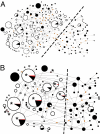Patterns of East Asian pig domestication, migration, and turnover revealed by modern and ancient DNA
- PMID: 20404179
- PMCID: PMC2867865
- DOI: 10.1073/pnas.0912264107
Patterns of East Asian pig domestication, migration, and turnover revealed by modern and ancient DNA
Abstract
The establishment of agricultural economies based upon domestic animals began independently in many parts of the world and led to both increases in human population size and the migration of people carrying domestic plants and animals. The precise circumstances of the earliest phases of these events remain mysterious given their antiquity and the fact that subsequent waves of migrants have often replaced the first. Through the use of more than 1,500 modern (including 151 previously uncharacterized specimens) and 18 ancient (representing six East Asian archeological sites) pig (Sus scrofa) DNA sequences sampled across East Asia, we provide evidence for the long-term genetic continuity between modern and ancient Chinese domestic pigs. Although the Chinese case for independent pig domestication is supported by both genetic and archaeological evidence, we discuss five additional (and possibly) independent domestications of indigenous wild boar populations: one in India, three in peninsular Southeast Asia, and one off the coast of Taiwan. Collectively, we refer to these instances as "cryptic domestication," given the current lack of corroborating archaeological evidence. In addition, we demonstrate the existence of numerous populations of genetically distinct and widespread wild boar populations that have not contributed maternal genetic material to modern domestic stocks. The overall findings provide the most complete picture yet of pig evolution and domestication in East Asia, and generate testable hypotheses regarding the development and spread of early farmers in the Far East.
Conflict of interest statement
The authors declare no conflict of interest.
Figures


Similar articles
-
Mining the pig genome to investigate the domestication process.Heredity (Edinb). 2014 Dec;113(6):471-84. doi: 10.1038/hdy.2014.68. Epub 2014 Jul 30. Heredity (Edinb). 2014. PMID: 25074569 Free PMC article. Review.
-
Insular East Asia pig dispersal and vicariance inferred from Asian wild boar genetic evidence.J Anim Sci. 2017 Apr;95(4):1451-1466. doi: 10.2527/jas.2016.1117. J Anim Sci. 2017. PMID: 28464072
-
Ancient DNA reveals the maternal genetic history of East Asian domestic pigs.J Genet Genomics. 2022 Jun;49(6):537-546. doi: 10.1016/j.jgg.2021.11.014. Epub 2021 Dec 10. J Genet Genomics. 2022. PMID: 34902603
-
Ancient DNA, pig domestication, and the spread of the Neolithic into Europe.Proc Natl Acad Sci U S A. 2007 Sep 25;104(39):15276-81. doi: 10.1073/pnas.0703411104. Epub 2007 Sep 13. Proc Natl Acad Sci U S A. 2007. PMID: 17855556 Free PMC article.
-
Recent developments in the genetic history of East Asia and Oceania.Curr Opin Genet Dev. 2014 Dec;29:9-14. doi: 10.1016/j.gde.2014.06.010. Epub 2014 Aug 23. Curr Opin Genet Dev. 2014. PMID: 25170982 Review.
Cited by
-
Global Survey of Variation in a Human Olfactory Receptor Gene Reveals Signatures of Non-Neutral Evolution.Chem Senses. 2015 Sep;40(7):481-8. doi: 10.1093/chemse/bjv030. Epub 2015 Jun 13. Chem Senses. 2015. PMID: 26072518 Free PMC article.
-
Population differentiated copy number variation between Eurasian wild boar and domesticated pig populations.Sci Rep. 2023 Jan 20;13(1):1115. doi: 10.1038/s41598-022-22373-z. Sci Rep. 2023. PMID: 36670113 Free PMC article.
-
The genomic landscape of mammal domestication might be orchestrated by selected transcription factors regulating brain and craniofacial development.Dev Genes Evol. 2023 Dec;233(2):123-135. doi: 10.1007/s00427-023-00709-7. Epub 2023 Aug 8. Dev Genes Evol. 2023. PMID: 37552321 Free PMC article.
-
Mining the pig genome to investigate the domestication process.Heredity (Edinb). 2014 Dec;113(6):471-84. doi: 10.1038/hdy.2014.68. Epub 2014 Jul 30. Heredity (Edinb). 2014. PMID: 25074569 Free PMC article. Review.
-
Runs of Homozygosity Preliminary Investigation in Pig Breeds.Animals (Basel). 2025 Mar 29;15(7):988. doi: 10.3390/ani15070988. Animals (Basel). 2025. PMID: 40218381 Free PMC article.
References
-
- Bellwood P. First Farmers: The Origins of Agricultural Societies. Oxford: Blackwell; 2005.
-
- Diamond J, Bellwood P. Farmers and their languages: The first expansions. Science. 2003;300:597–603. - PubMed
-
- Dobney K, Larson G. Genetics and animal domestication: New windows on an elusive process. J Zool. 2006;269:261–271.
-
- Zeder MA, Emshwiller E, Smith BD, Bradley DG. Documenting domestication: The intersection of genetics and archaeology. Trends Genet. 2006;22:139–155. - PubMed
Publication types
MeSH terms
Substances
Associated data
- Actions
- Actions
- Actions
- Actions
- Actions
- Actions
- Actions
- Actions
- Actions
- Actions
- Actions
- Actions
- Actions
- Actions
- Actions
- Actions
- Actions
- Actions
- Actions
- Actions
- Actions
- Actions
- Actions
- Actions
- Actions
- Actions
- Actions
- Actions
- Actions
- Actions
- Actions
- Actions
- Actions
- Actions
- Actions
- Actions
- Actions
- Actions
- Actions
- Actions
- Actions
- Actions
- Actions
- Actions
- Actions
- Actions
- Actions
- Actions
- Actions
- Actions
- Actions
- Actions
- Actions
- Actions
- Actions
- Actions
- Actions
- Actions
- Actions
- Actions
- Actions
- Actions
- Actions
- Actions
- Actions
- Actions
- Actions
- Actions
- Actions
- Actions
- Actions
- Actions
- Actions
- Actions
- Actions
- Actions
- Actions
- Actions
- Actions
- Actions
- Actions
- Actions
- Actions
- Actions
- Actions
- Actions
- Actions
- Actions
- Actions
- Actions
- Actions
- Actions
- Actions
- Actions
- Actions
- Actions
- Actions
- Actions
- Actions
- Actions
- Actions
- Actions
- Actions
- Actions
- Actions
- Actions
- Actions
- Actions
- Actions
- Actions
- Actions
- Actions
- Actions
- Actions
- Actions
- Actions
- Actions
- Actions
- Actions
- Actions
- Actions
- Actions
- Actions
- Actions
- Actions
- Actions
- Actions
- Actions
- Actions
- Actions
- Actions
- Actions
- Actions
- Actions
- Actions
- Actions
- Actions
- Actions
- Actions
- Actions
- Actions
- Actions
- Actions
- Actions
- Actions
- Actions
- Actions
- Actions
- Actions
- Actions
- Actions
- Actions
- Actions
- Actions
- Actions
- Actions
- Actions
- Actions
LinkOut - more resources
Full Text Sources

